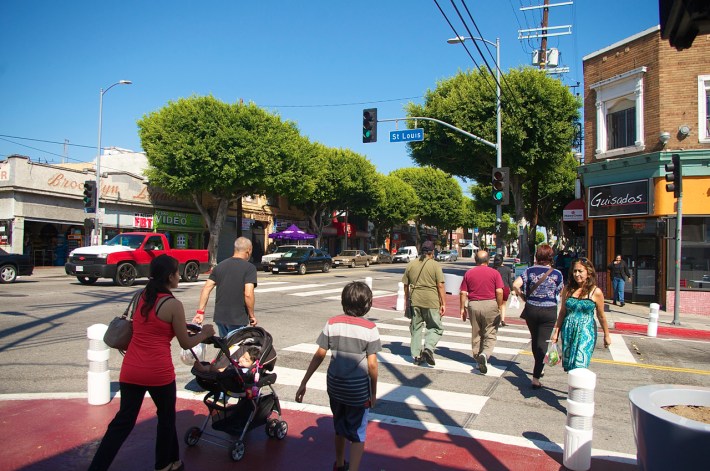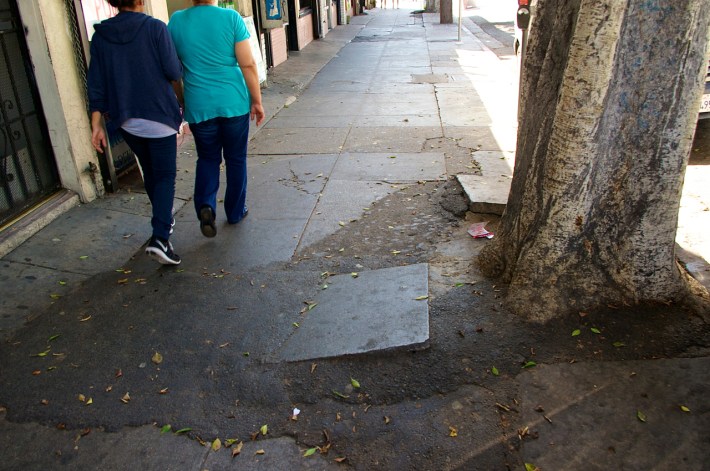
I've sat and observed the intersection of St. Louis and Cesar Chavez in Boyle Heights several times since the modified curb extensions started going in last month.
The painted "bulb-outs" are part of a pilot project of the Great Streets program (see recent coverage of its efforts on Central Ave. here) and are the first such curb extensions in the city.
Cesar Chavez is one of fifteen Great Streets identified in the current cycle, and is expected to see improvements stretching between St. Louis and Evergreen. But, for now, the improvements are limited to one intersection. And one of the calmer intersections along the corridor, at that, much to the puzzlement of a number of residents.
For one, people aren't exactly sure what they are looking at.
"Why is it red?" "What is that [pointing at empty planter]?" and "Why is that in the street?" are all questions frequently overheard, often from curious kids whose parents seem unsure how to answer.

"Is it for the bikes?" asked a young salesman handing out flyers in front of the cell phone shop just down the street. "'Cause, you know, they have those green sections on 1st St. for the bikes..."
No, I explained, these were curb extensions that limited the distance pedestrians would be exposed to traffic when moving across travel lanes. And they were paired with adjustments to the walk signals that now gave pedestrians a head start when crossing the street.

It was part of the Great Streets program, I said, and there would be improvements along the rest of this section of Cesar Chavez at some point -- but it was unclear when that would happen, or if the same improvements would appear at the other corners along the corridor.
He nodded and surveyed the intersection.
"They should have talked to us," he mused, referring to the businesses along the street.
It was not unusual for people to come in and ask business owners about changes to the area, he explained. But without any information about the program, the owners didn't know what to tell them. Especially about the more significant changes that were impacting the lives of the elderly residents in the community.
He gestured toward an elderly woman leaned wearily up against a telephone pole.
"They moved the bus stop over here and now elderly people have to stand instead of being able to sit down," he shook his head.
And it is unclear how long that change will be in effect. The signs say only, "until further notice."

A lot of elderly people have been slow to catch on to the change, concurred a man waiting for the bus.
They either hadn't been able to read the signs or hadn't realized what they meant, and so they continued to wait where they always had. Finally, he said, he went down and advised some of the folks he saw waiting at the wrong corner that the stop had been moved last week.
That corner had always been a tough one for buses to maneuver, he continued, as car drivers routinely disregarded the red curbs and parked near the stop. But the new bulb-outs had encroached on the space designated for the bus stop and apparently forced the change to the new site, a block and a half east.

The other key question the two men and others I've spoken with had was regarding the choice of the intersection. Why had the city begun at St. Louis? Other places, like Soto, they said, needed it more. Some wanted to know if it was because of the arrival of the restaurant Guisados on that corner and its popularity with non-resident foodies.
I was told only that there are a lot of crashes at that site; Great Streets' tumblr post on the topic explains that there are a lot of crashes along the corridor.
There are indeed a lot of crashes along the corridor. But they aren't happening at St. Louis.
As seen in the crash data-mapping done by the LA Times recently, the intersection with Soto is far and above the one of greatest concern, with 21 recorded pedestrian crashes between 2002 and 2013 (it is likely there are more that have not been recorded), and one fatality.

The intersection marked in fuzzy red to the west of Soto is Cummings, not St. Louis. St. Louis was in the clear, at least according to the data used to compile the map (appearing under the left-hand corner of the white box with the information about Cesar Chavez/Soto). Meaning that, if the goal of the pilot is to gather data and assess the safety benefits of bulb-outs, St. Louis was probably not the ideal place to start. Soto, Fickett (just the west of Soto, with 13 crashes), or Evergreen (which saw 10 crashes) might all have been more useful, data-wise.
And Soto could certainly use the help.
As a major transit hub hosting (wholly inadequate) bus stops on three corners on a very busy street, the intersection at Soto is almost always packed with people. The bus stop on the southwest corner alone can be fifteen or twenty deep in passengers during peak hours.

And while I actually rather like the look and feel of the intersection at St. Louis and the way that it shrinks the distance the many families on foot will be exposed to traffic, it is hard to ignore the fact that St. Louis is already quite narrow.
So, it is not unusual to see the delivery trucks, tow trucks, and garbage trucks that turn right onto St. Louis from Cesar Chavez now struggling to get around that corner. Even while moving at a crawl, they often appear unable to make the turn without swinging into the lane of oncoming traffic or blocking the pedestrian crossing as they wait for cars lined up on St. Louis to back up and allow them to pass.
As for when the other intersections along the corridor will be addressed, Great Streets' post says a community workshop will be held later this summer to focus on the treatments "up to nine other intersections" (from Cummings to Evergreen) should receive.

Those I spoke with along Cesar Chavez hoped that intersections would not be the only topic of conversation.
Obsolete and poorly-maintained street furniture and broken sidewalks that make passage difficult for the elderly and families with small children are also things folks would like to see addressed (see photos below).






For more information on Great Streets, visit their tumblr. Notice of the meeting about Cesar Chavez will be posted as soon as it is available.






